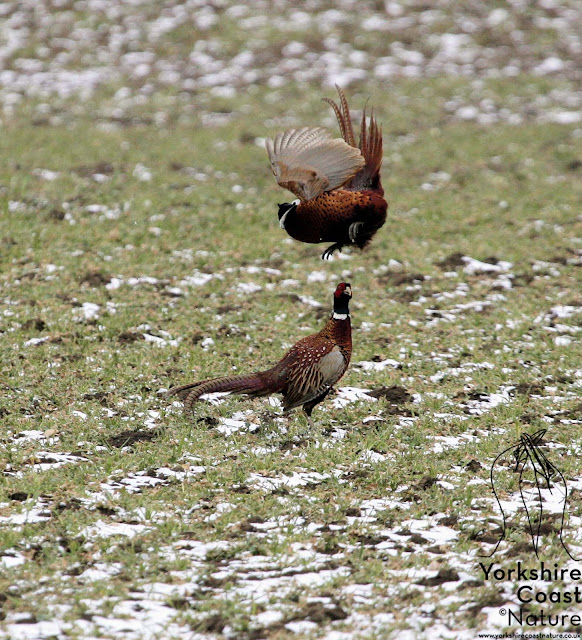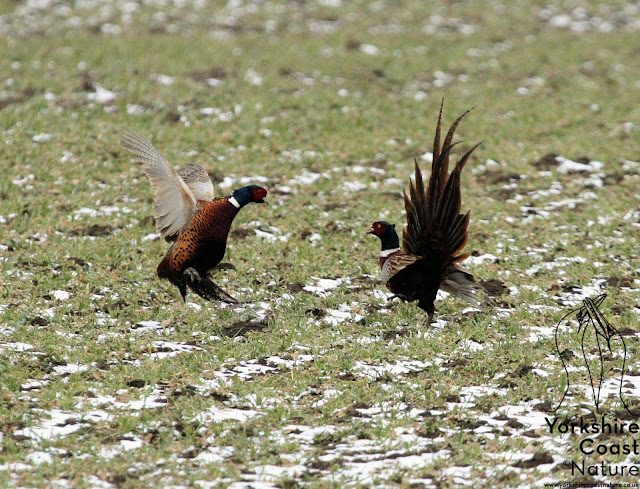The skies are constantly dark with snow heavy clouds, the
sea is battering the coast and the north easterly wind bites the skin. It's
hard to believe that we are days away from April a time of year one would
expect lambs in the fields, daffodils in bloom, ponds full of frogspawn and a
whole host of creatures and creepy-crawlies waking up to the summer after a
long winters slumber. Seems like many of these have had to endure a rather
forced lie-in. However I did manage to find common toad, common frog, smooth
newt and great crested newt earlier in the week whilst at work. I will get some
artistic amphibian shots this year, when it warms up. Reluctant to get soaked
and blown away on the cliff-tops or travel far in the poor dull weather, I have
made the farmland which surrounds my house my own once again, rekindling the
childhood spirit which originally got me hooked on natural history. A very real
sign of spring was present today however despite the mad march weather and that
was the sight of mad march hares, one of nature's super spring spectacles.
Boxing is generally the result of a female warding off a
males sexual advances, by rearing up and boxing him with her forepaws. This is
usually seen in unreceptive females which are near oestrus but not quite ready
to mate. Each female at this time of year is guarded by a male or a small
number of males (as seen in the photo 3). These will remain with the female and
generally stay within 5 metres from her daytime form (resting place). Males
naturally chase and fight each other for breeding rights. We tends to see
dominant males guarding near-oestrus females and attacking sub-ordinate males,
thus having a higher breeding success rate. Subordinates are bitten and chased
off, although boxing is unusual between males.
The term "mad march hare" is somewhat misleading
as hares often mate as early as January, with births between February and
October, brown hares have about 3 litters per year. These tend to consist of
1-4 leverets (young hares), early and late litters tend to have lower numbers
of leverets, possibly linked to female condition and food availability.
Interestingly females occasionally exhibit superfetation in which two different
aged embryos are present together in the uterus. Prior to giving birth female
tend to become shy and retire away from male attention, staying close to the
place in which they want to give birth for about two weeks.
Unfortunately the pheasant and partridge culture of the
region means foxes are controlled quite regularly (although my own scat counts
reveal populations remain stable with territories more or less saturated in the
area). This control probably helps the hares as foxes are their key predator in
Britain, and have been shown to limit population growth and productivity. In
extreme cases foxes can predate 80-100% of leverets in a season. I managed to
find a fox skull recently which gave me a good opportunity to take a closer
look at the species structure.
A bit of simple maths (Cough) using the Lynch equation and
we can sex red fox skulls.
D = (2.114 x GL) - (1.874 x PO) - 27.478
I am not much of a fan of maths so I will get to the point
the skull is from a male. Other ways of telling is the presence of a prominent
sagittal crest, which is suggestive of a slightly older male. However the good
condition of the teeth suggests it was not that old at the age of death,
probably c.12 months or more. Red fox skulls tend to have narrow muzzles and
longer canines in comparison to domesticated dogs (the only real confusion
species in Britain). They also show a concave upper surface to the post-orbital
process (bone which sticks out above the eye), this is convex in dogs.
Another hare predator which is prominent within this region
is the buzzard, although perhaps less of a problem to hares than foxes. Common
buzzards will no doubt take leverets, as well as rabbits. One was wheeling
around in the snow above the hares, but certainly locally these buzzards tend
not to close enough to be photographed. Although I did manage to see one with
an extremely young rabbit, a lagomorph similar to the brown hare but more
productive in terms of breeding and equally one which starts to mate early in
the year.
The little owl seems to be getting a bit more approachable,
but with the almost imminent onset of the breeding season, I will avoid any
close interactions with these birds which are easily spooked and can abort the
nest site early in the season prior to the egg/nestling period. Always nice to
see this species though. Hopefully we will remain snow free and these birds
will persist into the spring. I have been looking for other nest sites as
undoubtedly other birds will be in the area but have only found jackdaws thus
far.
It wasn't only the hares which were fighting in the fields today but also the male pheasants were getting a little shirty with one another.













No comments:
Post a Comment